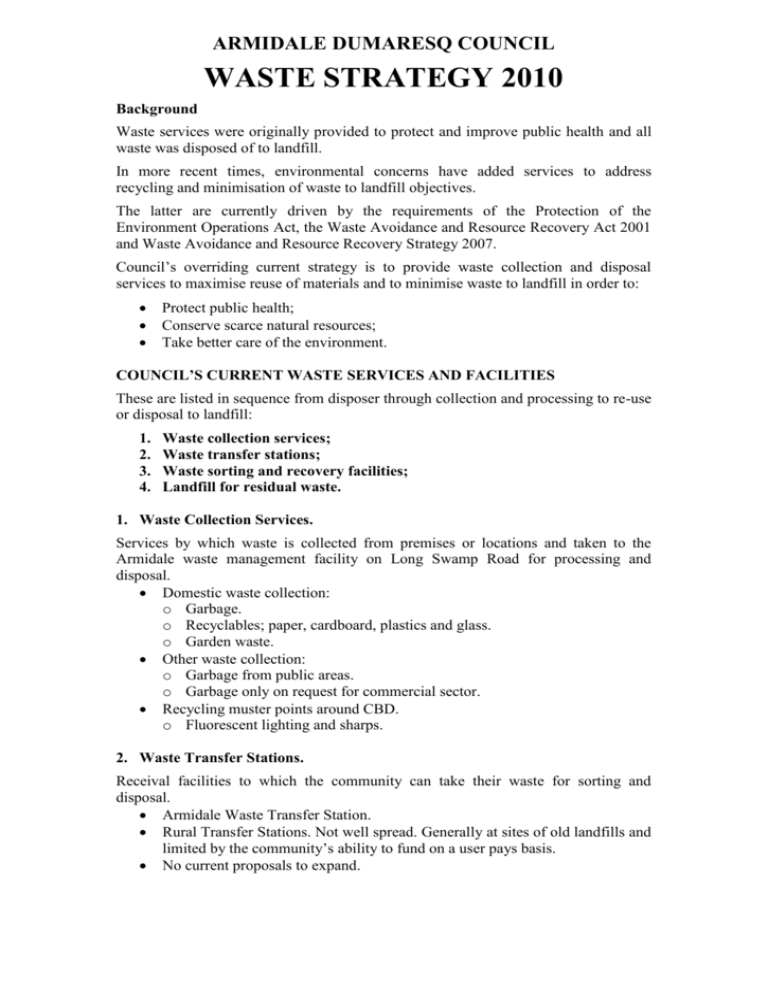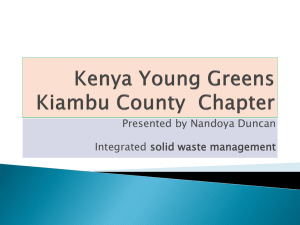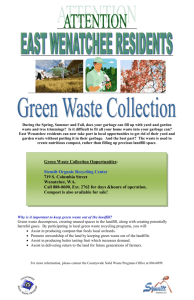Waste Strategy 2010 - Armidale Dumaresq Council
advertisement

ARMIDALE DUMARESQ COUNCIL WASTE STRATEGY 2010 Background Waste services were originally provided to protect and improve public health and all waste was disposed of to landfill. In more recent times, environmental concerns have added services to address recycling and minimisation of waste to landfill objectives. The latter are currently driven by the requirements of the Protection of the Environment Operations Act, the Waste Avoidance and Resource Recovery Act 2001 and Waste Avoidance and Resource Recovery Strategy 2007. Council’s overriding current strategy is to provide waste collection and disposal services to maximise reuse of materials and to minimise waste to landfill in order to: Protect public health; Conserve scarce natural resources; Take better care of the environment. COUNCIL’S CURRENT WASTE SERVICES AND FACILITIES These are listed in sequence from disposer through collection and processing to re-use or disposal to landfill: 1. 2. 3. 4. Waste collection services; Waste transfer stations; Waste sorting and recovery facilities; Landfill for residual waste. 1. Waste Collection Services. Services by which waste is collected from premises or locations and taken to the Armidale waste management facility on Long Swamp Road for processing and disposal. Domestic waste collection: o Garbage. o Recyclables; paper, cardboard, plastics and glass. o Garden waste. Other waste collection: o Garbage from public areas. o Garbage only on request for commercial sector. Recycling muster points around CBD. o Fluorescent lighting and sharps. 2. Waste Transfer Stations. Receival facilities to which the community can take their waste for sorting and disposal. Armidale Waste Transfer Station. Rural Transfer Stations. Not well spread. Generally at sites of old landfills and limited by the community’s ability to fund on a user pays basis. No current proposals to expand. WASTE STRATEGY 2010 (Continued) 3. Waste Sorting and Recovery Facilities. These processing activities have grown and continue to grow to meet the objectives of waste minimisation and materials re-use (recycling). Generally, recycling is not profit making and to be worthy, the processes we operate must have a healthy market for disposal and economic processing and transport costs as well as demonstrated environmental benefit before they can be considered practical and economic options for Armidale. Sorting at Source is Council’s preferred process for waste separation. o Council encourages sorting at source at all residential, commercial and industrial premises to minimise contamination of material. o Existing domestic sorting and collection operates very well. Crates system minimises contamination. Excellent community participation. o Commercial and industrial sector has some good pockets of sorting activity but overall there is significant room for improvement. At the Armidale Waste Transfer Station (WTS), a materials recycling facility (MRF) is operated to sort collected recyclables consisting of paper, cardboard, plastics, metal cans and plastic and glass containers. Also at the Armidale WTS, facilities are provided for receival and recycling of second hand goods, all metals, garden waste, builders waste, timber, chemicals, waste motor and cooking oil, paint, wet and dry cell batteries, fluorescent tubes and bulbs, tyres, electrical goods, computers and heavy plastics. Additional items are added as markets and costs dictate. Note that there is currently a commercial MRF operating on Council’s Long Swamp Road site that undertakes the sorting of mixed commercial & industrial waste on behalf of clients before the sorted waste is then disposed of through Council’s WTS. 4. Landfill for Residual Waste. Facility for disposal of residual waste left after recyclable material has been removed from waste. Landfill has operated at the current Long Swamp Road site since the 1960s. It will be full in next few years and a new landfill is required to take its place. Closure works will be required for the Long Swamp Road landfill on cessation of use. PROPOSED REPLACEMENTS AND AUGMENTATION OF COUNCIL’S WASTE SERVICES AND FACILITIES The major project that Council must undertake is the construction of the new landfill. During the process for the selection of the site for the new landfill, for environmental protection reasons, Council made the commitment to routinely operate the new landfill as a non-putrescible landfill as much as is practicable. The landfill would be licenced as a putrescible landfill to accommodate the essential intermittent need for disposal of putrescible material for which stabilisation or composting is not a practical option. Emanating from the above commitment is the need to augment our current processing facilities to deal with putrescible waste by way of composting or stabilisation. The following replacements, changes and augmentations are proposed to deal with putrescible waste and to improve waste recovery from commercial and industrial waste. Further facilities and processes to recover materials for re-use will be added in future as markets and recovery costs dictate WASTE STRATEGY 2010 (Continued) 1. New Landfill. 2. Organics (garden and food) waste collection service. 3. Processing facilities to deal with putrescible material - compost organic waste and stabilise residual waste containing putrescible material before landfilling. Commonly referred to in the industry as alternative waste treatment (AWT). 4. MRF for sorting of mixed commercial and industrial waste. Another AWT process. 1. New Landfill. Site has been selected off Waterfall Way about 12 kms from Armidale and the planning approval process is in progress. Environmental Assessment on public exhibition 3 June to 6 August 2010. Assuming no delays, commissioning of landfill expected by early 2012. All waste is to be routed through the Armidale Waste Transfer Station and its processes for waste recovery and stabilisation of putrescible material with only residual waste taken to the new landfill facility. To be funded by the new landfill annual charge introduced to meet costs of new landfill project. Charge will increase as the project progresses and actual costs are determined. 2. Organics (garden and food) Waste Collection Service. To enable foodwaste to be collected, it is proposed to change the existing fortnightly garden waste collection service to a weekly organics (garden waste and food waste) collection service. A public education program will be run to inform residents of the practicalities and benefits of the organics collection service. An organics (mainly food waste) collection service is proposed for the nonresidential sectors. May require to be funded by small increases in annual charges and transfer station charges depending on logistics and contract pricing. 3. Processing Facilities to deal with Putrescible Material: a) Compost Organic Waste and b) Stabilise Residual Waste that contains putrescible material before landfilling. Two new processes are to be established before the new landfill is operational: o Composting of well sorted organic waste – garden waste and food waste. o Stabilising of residual waste before it is placed into landfill. o These processes are currently being trialled and evaluated at the Long Swamp Road Waste Transfer Facility before full scale adoption and implementation. To be funded by increased annual charges and transfer station charges for disposal of this material. 4. MRF for Sorting of Mixed Commercial and Industrial Waste. Maintain penalty charges for the disposal of unsorted waste at transfer stations. Install a MRF for the sorting of non-putrescible mixed waste similar to the commercial facility currently operating on Council’s waste management facility. This facility will be funded from the penalty charges.






